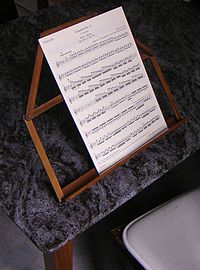Music stand
A music stand (also music stand ) is a console , which for storing music is used.
construction
Most music stands consist of a leg that, similar to a tripod , usually stands on three feet. The music rest is attached to it, an inclined board or grid , at the lower end of which a surface is attached at a right angle so that the music can be set up. The height of the leg can often be adjusted telescopically in order to adapt the music stand to the height of the musician, or to be able to play both standing and sitting. The angle of inclination of the shelf can be changed between horizontal and vertical. Many music stands are also equipped with a spring clip to prevent the notes from falling.
Various forms of consoles have emerged throughout history. Racks with several shelves on one leg, such as duo , trio or quartet music stands, were particularly popular . The latter was mostly made in a low version, as it was designed primarily for string quartets that make music while sitting.
On keyboard instruments is on the keyboard , a fixed panel mounted.
But there are also foldable table music stands that only consist of the tray and can be placed directly on a surface. This is a practical space saving in confined spaces.
So- called digital music stands are a fairly new phenomenon . These are i. d. Usually around the tripod of a conventional music stand, which instead of the foldable music rest carries a tablet adapter, possibly rotatable.
Advantages over a conventional music stand result from the electronic storage and display of the notes, which facilitates mobility; because even a large number of digital notes can be carried in this way. In the orchestra or on stage, notes can be quickly synchronized with other musicians. The pages can be turned using the touchscreen or foot pedal (forwards / backwards). Optionally, a metronome or an audio output can be integrated.
If the folding mechanism is handled incorrectly, it is not uncommon for the metal struts to be bent, which is why it is advisable to follow a fixed sequence.
orchestra
In the orchestra , each wind player and percussionist has their own desk on which their individual voice lies. The strings , in which several musicians play the same thing in each group, usually share a desk in pairs. This also has the advantage that not all musicians have to put down when turning the sheet music. Usually the person sitting outside (towards the edge of the stage) continues to play and the inside player turns the page .
The word desk in scores means two players . “Only one desk” is usually synonymous with “first desk” , meaning the section leaders or concert masters .
Modern orchestra stands are usually equipped with a desk lamp that illuminates the notes without shining in other directions, which is particularly important in the dark orchestra pit of an opera house in order not to distract from the action on the stage. In addition, a desk tray is often attached to the leg , a small board on which the musician can place pencils or accessories such as mutes or reeds .
Marching forks are usually used as a music rest when playing while marching .





